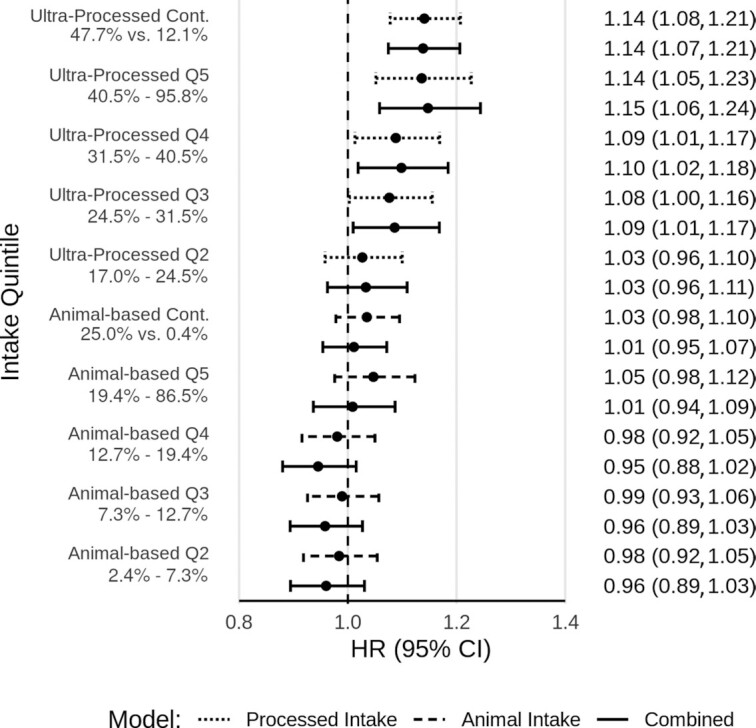FIGURE 2.

Ultra-processed food intake and animal-based food intake and all-cause mortality. Fully adjusted HRs and 95% CIs for ultra-processed food intake and animal-based food intake and all-cause mortality, from Cox proportional hazards regression (n = 77,437). Results with dotted lines are for the proportion of dietary energy from ultra-processed foods, modeled alone. Results with hashed lines are for the proportion of dietary energy from animal-based foods (meats, dairy, eggs), modeled alone. Results with solid lines are for both modeled together. Results labeled Q2–Q5 are for the second through fifth quintiles (Q1 as reference). Ranges of intake as percentages of total dietary energy are given for each quintile. Results labeled Cont. are for continuous linear models, comparing the 90th and 10th percentiles of intake. Levels of intake as percentages of total dietary energy are presented for these contrasts. Adjusted for age (i.e., attained age as time variable), sex (male, female), race (black, nonblack), geographic region (West, Northwest, Mountain, Midwest, East, South), education (up to high school graduate, trade school/some college/associate degree, bachelor degree, graduate degree), marital status (married/common-law, never married, widowed, divorced/separated), smoking (current smoker, quit <1 y, quit >1–5 y, quit >5–10 y, quit >10–20 y, quit >20–30 y, quit >30 y, never smoked), alcohol [nondrinker, rare drinker (<1.5 servings/mo), monthly drinker (1.5 to <4 servings/mo), weekly drinker (4 to <28 servings/mo), daily drinker (≥28 servings/mo)], exercise (i.e., “vigorous activities, such as brisk walking, jogging, bicycling, etc., long enough or with enough intensity to work up a sweat, get your heart thumping, or get out of breath”) (none, ≤20 min/wk, 21–60 min/wk, 61–150 min/wk, ≥151 min/wk), sleep duration (≤4 h/night, 5 to ≥9 h/night), menopause (in women) [premenopausal (including perimenopausal), postmenopausal], hormone replacement (in postmenopausal women) (not taking hormone replacement, taking hormone replacement), BMI (in kg/m2) [restricted cubic spline with knots at the 5th (19.7), 27.5th (23.4), 50th (26.1), 72.5th (29.4), and 95th (38.6) percentiles], total dietary energy (kcal/d), prevalent cardiovascular disease (coronary bypass, angioplasty/stent, carotid artery surgery, heart attack, or stroke; or angina pectoris or congestive heart failure treated in the last 12 mo) (yes, no), and diabetes mellitus active or treated in the last 12 mo (yes, no). Q, quintile.
